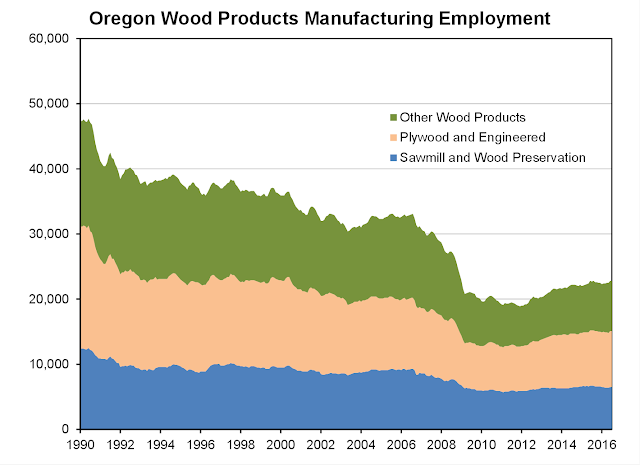By Oregon Employment Department,
Between 1990 and 2016, annual average employment in wood product manufacturing dropped 23,600, or 51 percent. Similar losses were experienced in all subsectors, with sawmills and wood preservation dropping 5,400 (45%); plywood and engineered wood products dropping 9,500 (53%), and all other wood product manufacturing, which includes millwork and prefabricated buildings, dropping 8,800 (54%).
Several structural shifts in the wood products industry have contributed to the employment decline. First, there was a drop in timber harvests from environmental concerns in the early 1990s. As harvest from federal lands reduced the amount of available raw material to mills, employment dropped, indicating that harvest reductions were a cause for the employment loss in the early 1990s.
New technologies brought another structural change to the industry by making lumber mills less labor intensive. Employment continued to drop even after harvest levels stabilized in the late 1990s and did not increase much despite a housing construction boom in the mid-2000s. Jobs in wood product manufacturing per million board feet harvested dropped steadily after 2000, likely due to technology.
In addition to new technologies, smaller mills were shuttered, creating efficiency through economies of scale (larger mills can produce more per worker). The average production of sawmills operating in the western U.S. increased as smaller mills were shuttered and efficiency increased through economies of scale and new technology.
Lumber production per worker in Oregon increased rapidly in the early 2000s then dropped during the recession. It’s likely that mills cut production through fewer hours instead of letting go of workers during the recession. After the recession, production per worker increased to the elevated levels it had reached before the recession.
Oregon’s Wood Product Manufacturing Industry Is Still Important, Especially in Rural Areas
Even with the decline, wood product manufacturing is still a large industry in Oregon. In 2015 there were 22,403 people employed and over $1 billion in total payroll in wood product manufacturing. While statewide the industry makes up only 1.3 percent of total employment and 1.2 percent of total payroll, the concentration is much higher in some counties, especially rural ones. For instance, in Douglas County, 8.2 percent of total employment and 10.7 percent of total payroll was in wood product manufacturing. Most of the counties with a high concentration of employment in wood product manufacturing are rural.
In counties where the percent of total payroll exceeds the percent of total employment, average wages are higher in wood product manufacturing than the overall average wage. This is the case in most of the rural counties listed, indicating that wood product manufacturing provides some of the higher paying jobs in rural counties.
For more, read Brian Rooney’s full article, Oregon’s Wood Product Manufacturing Industry Is Still Important, Especially in Rural Areas
Disclaimer: Articles featured on Oregon Report are the creation, responsibility and opinion of the authoring individual or organization which is featured at the top of every article.



